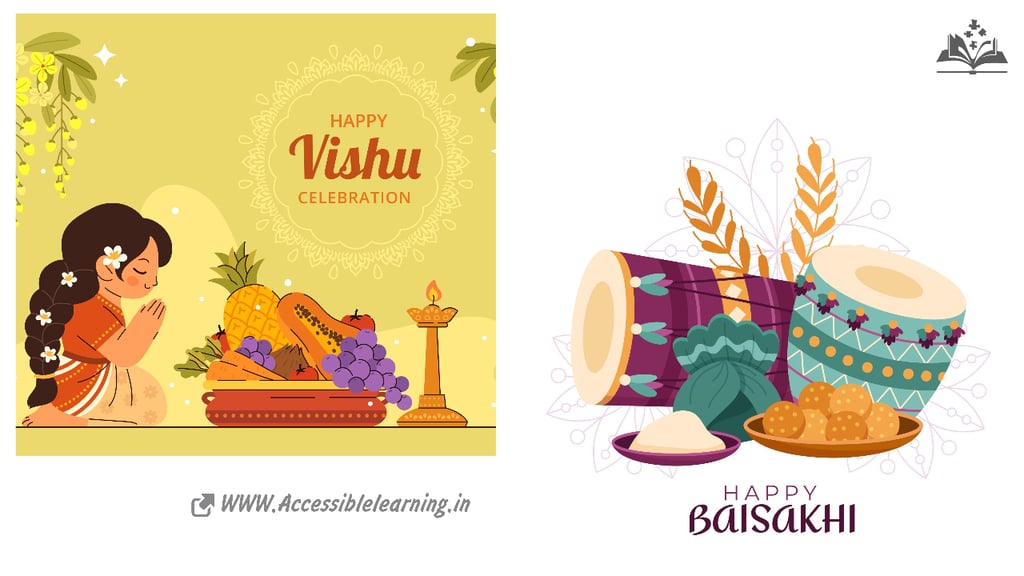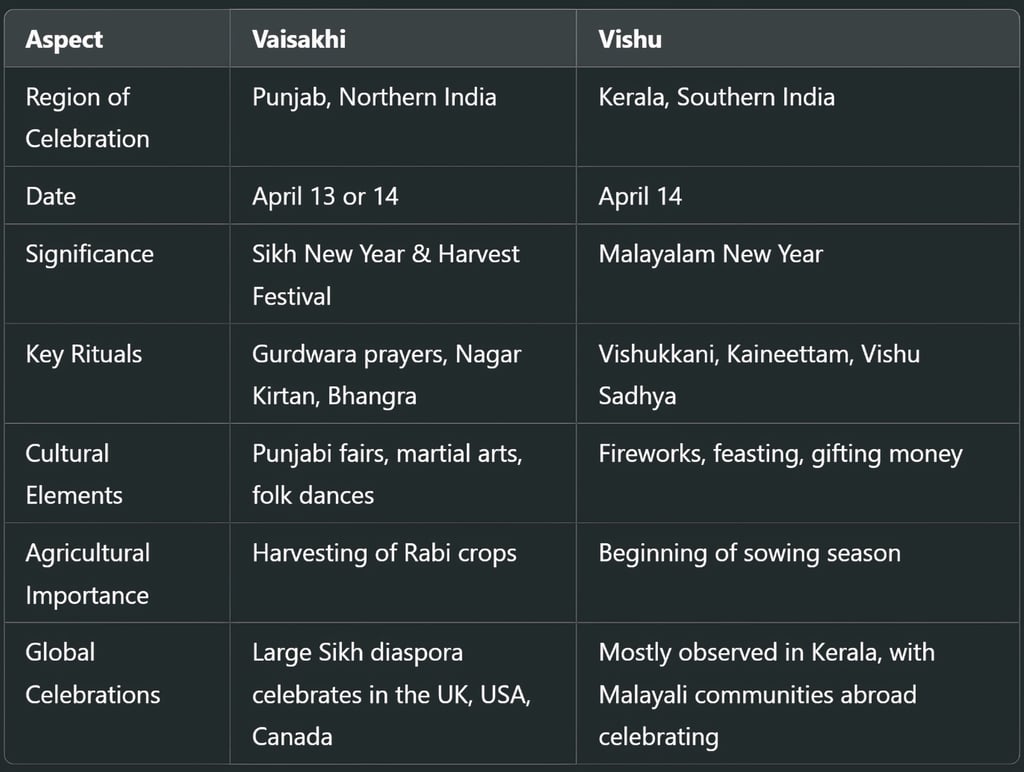
Vaisakhi & Vishu: A Celebration of Harvest, Culture, and New Beginnings
Discover the vibrant traditions of Vaisakhi and Vishu, two major Indian festivals celebrating harvest, culture, and new beginnings. Learn about their historical significance, rituals, and modern-day celebrations, highlighting the spirit of prosperity, gratitude, and joy.
CULTURE/TRADITIONEVENT/SPECIALEDUCATION/KNOWLEDGEINDIA/BHARATCELEBRATION/FESTIVALS
Keshav Jha
4/8/20253 min read


India, a land of diverse traditions, celebrates its rich cultural heritage through vibrant festivals. Vaisakhi and Vishu are two such significant festivals, deeply rooted in history, spirituality, and agricultural prosperity. While Vaisakhi is primarily celebrated in Punjab and marks the Sikh New Year and harvest festival, Vishu is observed in Kerala as the traditional New Year according to the Malayalam calendar. Let’s explore the significance, customs, and festive spirit of these joyous occasions.
Vaisakhi: A Festival of Harvest and Sikh Identity
Historical and Cultural Significance
Vaisakhi, celebrated on April 13 or 14, is one of the most important festivals in Punjab. Originally a harvest festival, it gained religious significance in 1699 when Guru Gobind Singh Ji, the tenth Sikh Guru, established the Khalsa Panth—a community of initiated Sikhs who uphold justice and righteousness. This event laid the foundation of Sikh identity, emphasizing courage and unity.
How Vaisakhi is Celebrated
Religious Observances: Sikhs visit Gurdwaras, where prayers and kirtans (devotional songs) are performed. The sacred text, Guru Granth Sahib, is read in Akhand Path (continuous recitation).
Nagar Kirtan Processions: Devotees take part in colorful street processions, singing hymns and showcasing Sikh martial arts (Gatka).
Langar (Community Feast): Free meals are served at Gurdwaras, embodying the Sikh principles of equality and selfless service.
Bhangra and Gidda Dances: Celebrations in Punjab include energetic folk dances, Bhangra (by men) and Gidda (by women), symbolizing joy and prosperity.
Fairs and Festivities: Rural fairs feature traditional games, music, and handicrafts, making Vaisakhi a lively experience.
Wheat Harvesting: Since Punjab is known as the ‘Granary of India,’ farmers mark the occasion by harvesting their rabi (winter) crops and praying for a prosperous year ahead.
Vaisakhi Parades Abroad: Due to the large Punjabi diaspora, Vaisakhi celebrations are also held in Canada, the UK, and the USA, showcasing Sikh heritage on a global scale.
Vishu: Kerala’s New Year Celebration
Meaning and Spiritual Importance
Vishu, the New Year festival of Kerala, falls on April 14 and marks the beginning of Medam, the first month of the Malayalam calendar. It symbolizes prosperity, hope, and renewal. The most important ritual of Vishu is Vishukkani, meaning “the first sight” of the new year, believed to bring good fortune.
Rituals and Traditions of Vishu
Vishukkani Darshan: The first sight of the day is an elaborate arrangement of auspicious items, including:
A mirror (symbolizing self-reflection)
Golden fruits (like jackfruit and mangoes)
Rice and grains (representing abundance)
Sacred items like the Kani Konna (golden shower tree flowers) and a lit lamp.
Vishu Kaineettam: Elders gift money to younger family members, signifying blessings and prosperity.
Vishu Sadhya (Grand Feast): Families prepare a lavish meal, featuring traditional Kerala dishes such as avial, sambar, payasam, and banana chips.
Fireworks and Festivities: The festival is also marked by fireworks, known as Vishu Padakkam, bringing an element of excitement to the celebrations.
Temple Visits: Devotees visit temples like Sree Padmanabhaswamy Temple (Thiruvananthapuram) and Guruvayur Temple, offering prayers for prosperity.
Agricultural Significance: Farmers begin sowing new crops, considering Vishu as an auspicious time to start fresh agricultural activities.


Modern Relevance and Global Appeal
Vaisakhi Beyond Punjab: With globalization, Vaisakhi has evolved beyond a Punjabi festival. It is recognized worldwide, with official celebrations in countries like Canada and the UK, where parades and community gatherings strengthen Sikh identity.
Vishu and the Malayali Diaspora: Malayalis living abroad, especially in the Middle East, the USA, and Australia, celebrate Vishu with traditional customs, ensuring cultural continuity across generations.
Eco-Friendly Celebrations: In recent years, both Vaisakhi and Vishu have seen an increase in sustainable practices, such as avoiding plastic decorations, using organic colors, and reducing food waste.
Social Media and Digital Celebrations: Virtual Vishu and Vaisakhi greetings, live-streamed Gurdwara services, and digital Vishukkani arrangements have gained popularity, allowing people worldwide to celebrate.
Both Vaisakhi and Vishu embody the spirit of new beginnings, gratitude, and prosperity. While Vaisakhi marks a historical and religious milestone in Sikhism and the agrarian lifestyle of Punjab, Vishu celebrates renewal and abundance in Kerala’s cultural fabric. Despite their regional differences, these festivals highlight India's rich traditions and the universal joy of celebrating life’s blessings. Whether through prayers, feasts, or vibrant festivities, Vaisakhi and Vishu unite communities in a shared spirit of joy and hope for the future.
With their deep-rooted historical, agricultural, and spiritual significance, Vaisakhi and Vishu continue to be celebrated with unwavering enthusiasm, bridging the past with the present and inspiring future generations.
Happy Vaisakhi & Vishu!
Subscribe To Our Newsletter
All © Copyright reserved by Accessible-Learning Hub
| Terms & Conditions
Knowledge is power. Learn with Us. 📚


